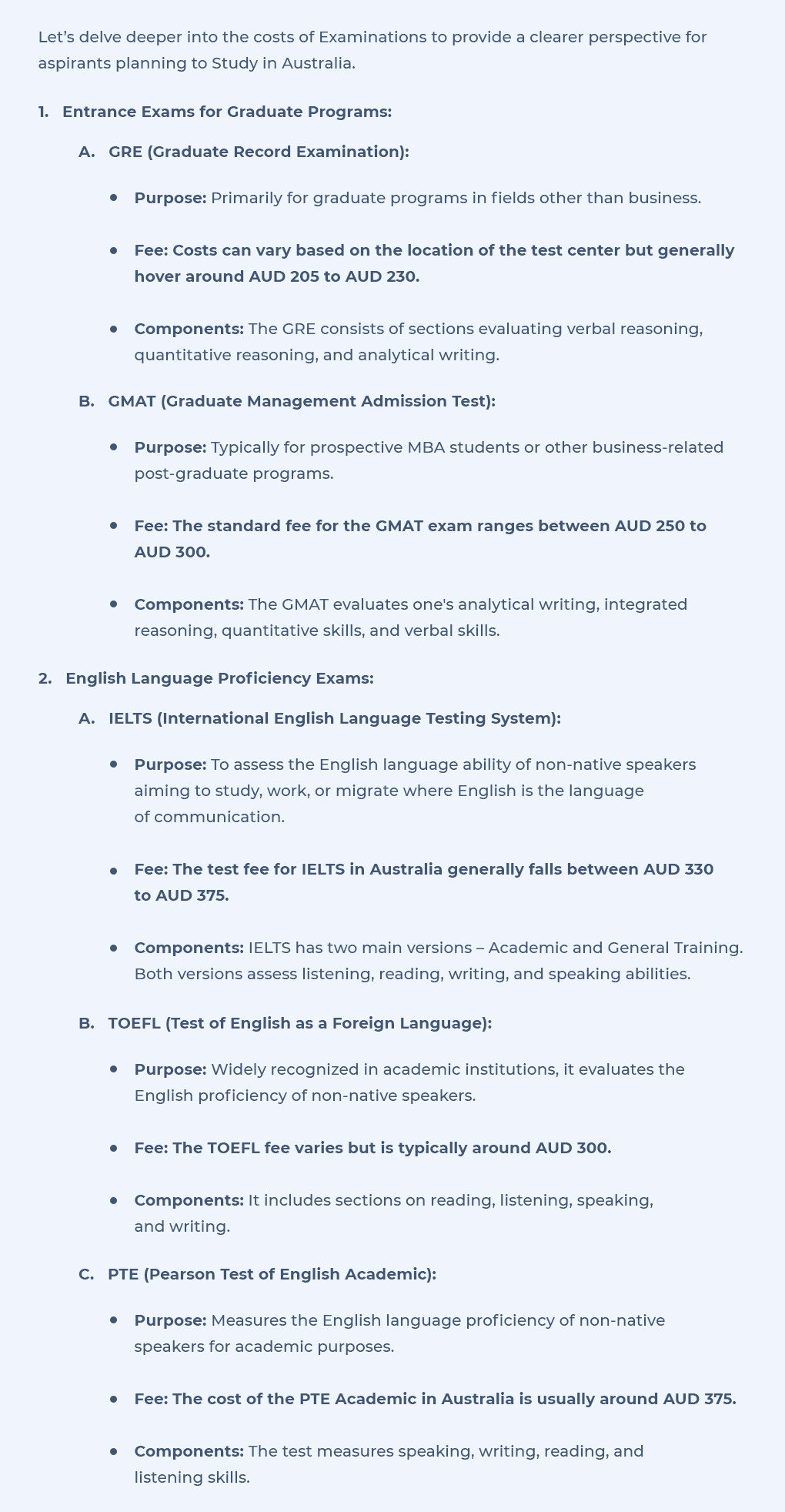

As of March 2022, Australia has seen a consistent rise in its international student numbers, with enrolments reaching 440,219. This marks an 11% increase compared to the previous year. Such statistics not only highlight a significant economic transformation but also elevate Australia to the position of the second-most sought-after global destination for overseas students, following closely behind the USA.
There's an abundance of factors that make Australia a magnet for students globally. While Australia stands toe-to-toe with other nations in boasting top-tier universities, it's their unwavering commitment to innovation, distinguished faculty, and high-calibre education that propels their institutions forward. Beyond the educational allure, Australia distinguishes itself with its unparalleled living standards and the assurance of a fulfilling student experience.
However, before making the decision to study Down Under, it's paramount to understand the associated costs. This comprehensive guide will delve deep into the financial aspects of studying in Australia, ensuring you’re well-informed and prepared.
This comprehensive guide will delve deep into the financial aspects of studying in Australia, ensuring you’re well-informed and prepared.
In this blog we will cover the following topic:
Australia's educational institutions, while being globally recognized for their quality, come with varied course fee depending on several factors:

Australia promises a high standard of living, which, albeit attractive, can be on the pricier side.


Dining at a modest restaurant will set you back about 18 AUD on average for a meal. In contrast, a three-course dining experience for a pair averages at 80 AUD. For those with a palate for diverse flavors, there's an array of Asian, Greek, and Italian eateries to explore.
International students residing in Australia typically require between 1,400 and 2,500 AUD monthly to cater to their living costs, encompassing housing, meals, and leisure activities. It's crucial to note that while applying for the student visa in Australia, students must demonstrate their financial capability to support their stay and education in the nation.
Here's an approximate budget for some of Australia's renowned student-friendly cities:

To know more about Standard of Living in Australia Read our Blog: Standard of Living in Australia: A Comprehensive Guide for International Students.
Your residence location may entitle you to regional discounts through programs in places like Queensland (QLD), South Australia (SA), or Melbourne (VIC). In the absence of these, a student's public transport pass typically ranges from 30 to 70 AUD/month, varying by city.
Bicycling is another viable commuting option. Renting a bike can cost approximately 40 AUD daily.
It's mandatory for international students to have Overseas Student Health Cover (OSHC). Depending on the provider and the plan, this can cost between AUD 500 and AUD 700 per year.
To know more about Medical and Health care facilities for International Students in Australia read our blog: Medical And Health Care Facilities For International Students In Australia.

Pursuing higher education often means investing in essential resources to support learning. In Australia, as is the case globally, the cost of study materials and equipment can vary significantly based on the discipline chosen.
For some courses, especially in the humanities and social sciences, the reliance on books might be more, costing anywhere between AUD 200 to AUD 500 annually.
The cost of these can quickly add up, pushing the yearly budget to the AUD 1000 - AUD 1500 range or even higher in some specialized courses.
These digital tools can add an additional AUD 100 to AUD 500 to the annual cost, depending on the course requirements.
Although these might seem minor, they can add up to AUD 100 - AUD 300 annually.
Australia, with its world-class institutions and diverse educational offerings, continues to magnetize international students. While the allure of studying Down Under is undeniable, navigating the preliminary steps, especially financial commitments associated with entrance and proficiency exams, can seem daunting.

Why Are These Exams Important?
Recommendations:
The Australian Student Visa (subclass 500) comes with an application charge of AUD 620.
To know more about Student Visa for Australia Read our Blog: A comprehensive Guide to Student Visa for Australia: Types, Requirements, and Application Process
Australia, often termed the "Land Down Under," is celebrated not only for its top-tier universities but also its rich tapestry of natural wonders, vibrant cities, and a myriad of recreational activities.
As an international student, the experience is not just limited to the classroom; exploring the beauty and cultural dynamism of Australia is integral to the overall experience.
However, indulging in these activities does come with its set of expenses.
International students in Australia are afforded the opportunity to work part-time, allowing them to not only support themselves financially but also gain valuable work experience in a different cultural environment. With an Australian student visa, students can legally work up to 20 hours a week during their academic term and can work full-time during their semester breaks.
While this opportunity offers financial relief, especially in managing tuition and living expenses, it's essential to be aware of the Australian tax system for income generated through part-time employment. Before starting work, students are required to secure a Tax File Number (TFN). The process to obtain a TFN is straightforward, with applications easily made online through the Australian Taxation Office's official website.
Many international students in Australia opt for part-time roles that match their skills, schedules, and career aspirations. Some commonly pursued job options include:
Numerous Australian universities offer scholarships, grants, and fellowships to international students, which can significantly reduce the financial burden. Each scholarship has its unique set of eligibility criteria, set forth by the respective providers.
Nevertheless, the majority of these scholarships are open to all international students, ensuring that financial constraints don't hinder deserving candidates. For a comprehensive list, the official 'Study in Australia' website serves as a rich resource.
Highlighted below are some notable scholarships available to international students:
In addition to the scholarships mentioned above, the Studyportals Scholarship is another potential funding source for students. This can be especially beneficial for those seeking financial assistance for their overseas academic pursuits.
While Australia undeniably comes with its own spectrum of costs, a side-by-side comparison with global education heavyweights like the USA and the UK often showcases an interesting observation. The expenses in Australia frequently align with, if not undercut, those found in the aforementioned nations. This becomes especially prominent when weighing the return on investment across key parameters such as the calibre of education, available job prospects, and the overall standard of living.
Conducting a thorough evaluation of educational quality versus the expenditure among major global educational hubs elucidates that Australia stands out as a cost-effective destination for prospective students. Not only are the living and tuition expenses generally more budget-friendly in comparison to countries like the US and the UK, but Australia also boasts one of the highest living standards globally.
Moving to a new country for studies is an exciting endeavour, but it also comes with the challenge of managing finances in a foreign land. The cost of living, coupled with tuition fees and personal expenses, can add up quickly. However, with a bit of planning and some smart strategies, international students can navigate through their academic journey in Australia without undue financial strain. Here are some elaborative tips to manage expenses:
Australia, with its stellar educational institutions and quality of life, is undeniably an attractive prospect for international students. While the cost of education and living might seem daunting initially, with meticulous planning, scholarships, and part-time work opportunities, it becomes much more manageable.
If the Land Down Under is your dream destination, don’t let the costs deter you. Look at it as an investment in your future, one that promises rich dividends in terms of knowledge, experiences, and opportunities.

Studying abroad is an exciting and life-changing experience that offers students a chance to gain a global perspective and valuable exposure ...

In our rapidly globalizing world, where boundaries are melting away and opportunities abound, proficiency in the English language has become ...

Choosing to pursue higher education abroad is an exciting and life-changing decision. Among the plethora of options available to internationa...

Studying abroad is a life-altering adventure that opens doors to new cultures, experiences, and opportunities. Among the plethora of global s...

Australia, renowned for its world-class education and diverse cultural experiences, continues to be a favoured destination for international ...

Australia is not just famous for its iconic Sydney Opera House, the Great Barrier Reef, and its unique wildlife; it is also recognized global...

Studying abroad is a life-changing decision, and with so many options available, it can be overwhelming to choose the right country and univers...

In the coming, international students continue to be drawn to the United Kingdom for its world-class education and diverse cultural experiences...